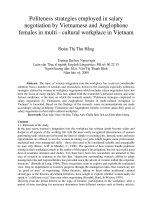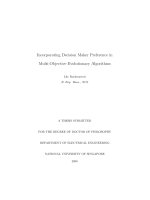Evolutionary multi objective optimization in scheduling problems
Bạn đang xem bản rút gọn của tài liệu. Xem và tải ngay bản đầy đủ của tài liệu tại đây (4.13 MB, 249 trang )
EVOLUTIONARY MULTI-OBJECTIVE
OPTIMIZATION IN SCHEDULING PROBLEMS
CHEONG CHUN YEW
B.Eng (Hons., 1st Class), NUS
A THESIS SUBMITTED
FOR THE DEGREE OF DOCTOR OF PHILOSOPHY
DEPARTMENT OF ELECTRICAL & COMPUTER ENGINEERING
NATIONAL UNIVERSITY OF SINGAPORE
2009
i
Abstract
The primary aim of this thesis is to present an investigation on the application of
multi-objective evolutionary algorithms (MOEAs) to solve a few real-world
scheduling problems with vastly different characteristics. Real-world scheduling
problems are generally complex, large scale, constrained, and multi-objective in
nature that classical operational research techniques are inadequate at solving them
effectively. Optimal solutions to these problems in today’s productivity-oriented
world would have significant economic and social consequences. In this thesis, a
generic MOEA framework is devised and problem-specific operators are then
designed to adapt the MOEA to solve the different scheduling problems. The research
documented in this thesis represents one of the pioneering works on multi-objective
optimization of each of the scheduling problems investigated.
One of the scheduling problems considered in this thesis is a two-objective exam
timetabling problem (ETTP), which involves the scheduling of exams for a set of
university courses into a timetable such that there are as few occurrences of students
having to take exams in consecutive periods as possible but at the same time
minimizing the timetable length and satisfying hard constraints such as limited
seating capacity and no overlapping exams. While existing approaches require prior
ii
knowledge of the timetable length in order to be effective, the MOEA proposed in
this thesis provides a more general solver to the ETTP by including the timetable
length as an optimization objective.
A berth allocation problem (BAP), which requires the determination of exact
berthing times and positions of incoming ships in a container port, is also studied in
this thesis. The BAP considers three objectives of minimizing makespan, waiting
time, and degree of deviation from a predetermined priority schedule, which represent
the interests of both port and ship operators. The experimental results reveal several
interesting relationships between the objectives, justifying the multi-objective
approach to the problem, which has never been explored for this problem.
This thesis also considers a three-objective vehicle routing problem with
stochastic demand (VRPSD), which involves the routing of a set of identical vehicles
with limited capacity from a central depot to a set of geographically dispersed
customers to satisfy their demands. Unlike the ETTP and the BAP, where all aspects
of the problem are known at the point of solving the problem, the VRPSD is a
stochastic optimization problem and some problem parameters are uncertain during
the solution-searching process. In the VRPSD, the actual demand of each customer is
unknown during the routing process but is revealed only when the vehicle reaches the
customer. The experimental results show that the solutions obtained by the MOEA
are robust to the stochastic nature of the problem.
iii
Acknowledgements
First and foremost, I would like to thank my Ph.D. supervisor, Associate Professor
Tan Kay Chen for introducing me to the wonderful field of computational
intelligence and giving me the opportunity to pursue research. His indispensable
guidance and advices, both academically and personally, have kept my work on
course during the past four years.
I am also grateful to my fellow lab buddies at the Control and Simulation
Laboratory, who have one way or another made my Ph.D. life very enjoyable: Chi
Keong for being the Grand Jedi Master of our research group, Dasheng for
maintaining the group server, Eujin for looking after the lab after we have all gone
home, Brian for providing lunch ferry service in his Man U Mobile, Hanyang for
accompanying me from the first day till the last, Chiam for bringing me into the
world of “software beta testing”, Chin Hiong for providing a venue for our group’s
research on “dry swimming”, and Chen Jia and Vui Ann for being the replacements. I
would also wish to express my gratitude to the lab officers, including Hengwei, Sara,
and Chee Siong, for the assistance provided during my time in the lab.
Last but not least, I would like to thank my family for all their love and care.
This thesis would not have been possible without their consistent support.
iv
Publications
Journals
K. C. Tan, C. Y. Cheong, and C. K. Goh, “Solving multiobjective vehicle routing
problem with stochastic demand via evolutionary computation”, European
Journal of Operational Research, vol. 177, no. 2, pp. 813 – 839, 2007.
C. Y. Cheong, K. C. Tan, and B. Veeravalli, “A multi-objective evolutionary
algorithm for examination timetabling”, Journal of Scheduling, vol. 12, no. 2, pp.
121 – 146, 2009.
C. Y. Cheong, K. C. Tan, D. K. Liu, and C. J. Lin, “Multi-objective and prioritized
berth allocation in container ports”, Annals of Operations Research, in press.
C. K. Goh, K. C. Tan, C. Y. Cheong, and Y. S. Ong, “An investigation on noise-
induced features in robust evolutionary multi-objective optimization”, Expert
Systems with Applications, in press.
K. C. Tan, C. Y. Cheong, and Y. Peng, “A genetic algorithm approach for real-time
identification and control of a helicopter system”, International Journal of
Innovative Computing, Information and Control, submitted.
Conference Papers
C. Y. Cheong, K. C. Tan, D. K. Liu, and J. X. Xu, “A multiobjective evolutionary
algorithm for solving vehicle routing problem with stochastic demand”, in
Proceedings of the IEEE Congress on Evolutionary Computation 2006, CEC
2006, Vancouver, Canada, pp. 5519 – 5526, 2006.
C. Y. Cheong, K. C. Tan, and B. Veeravalli, “Solving the exam timetabling problem
via a multi-objective evolutionary algorithm – a more general approach”, in
Proceedings of the 2007 IEEE Symposium on Computational Intelligence in
Scheduling, CI-Sched 2007, Honolulu, HI, USA, pp. 165 – 172, 2007.
v
C. Y. Cheong, S. C. Chiam, and C. K. Goh, “Eliminating positional dependency in
binary representation via redundancy”, in Proceedings of the 2007 IEEE
Symposium on Foundations of Computational Intelligence, FOCI 2007,
Honolulu, HI, USA, pp. 251 – 258, 2007.
C. Y. Cheong, C. J. Lin, K. C. Tan, and D. K. Liu, “A multi-objective evolutionary
algorithm for berth allocation in a container port”, in Proceedings of the 2007
IEEE Congress on Evolutionary Computation, CEC 2007, pp. 927-934, 2007.
C. K. Goh, K. C. Tan, C. Y. Cheong, and Y. S. Ong, “Noise-induced features in
robust multi-objective optimization problems”, in Proceedings of the 2007 IEEE
Congress on Evolutionary Computation, CEC 2007, pp. 568-575, 2007.
C. Y. Cheong, K. C. Tan, and D. K. Liu, “Solving the berth allocation problem with
service priority via multi-objective optimization”, in Proceedings of the 2009
IEEE Symposium on Computational Intelligence in Scheduling, CI-Sched 2009,
Nashville, TN, USA, pp. 95 – 102, 2009.
Book Chapters
C. Y. Cheong and K. C. Tan, “A multi-objective multi-colony ant algorithm for
solving the berth allocation problem”, Advances of Computational Intelligence in
Industrial Systems, Y. Liu, A. Sun, H. T. Loh, W. F. Lu, and E P. Lim (Eds.),
Springer-Verlag, pp. 333 – 350, 2008.
C. Y. Cheong and K. C. Tan, “Hybridizing problem-specific operators with meta-
heuristics for solving the multi-objective vehicle routing problem with stochastic
demand”, Bio-Inspired Approaches for the Vehicle Routing Problem, F. B.
Pereira and J. Tavares (Eds.), Springer-Verlag, pp. 101 – 129, 2009.
vi
Contents
Abstract i
Acknowledgements iii
Publications iv
List of Figures x
List of Tables xiv
List of Abbreviations xvi
1 Introduction 1
1.1 Background 1
1.2 Motivation 2
1.2.1 Multi-Objective Optimization in Scheduling Problems 3
1.2.2 Multi-Objective Evolutionary Algorithms 4
1.2.3 Why are Evolutionary Algorithms Suitable for Multi-Objective
Problems 4
1.2.4 Why are Evolutionary Algorithms Suitable for Scheduling Problems
6
1.3 Organization of this Thesis 7
2 A Review of Multi-Objective Evolutionary Algorithms 10
2.1 Basic Concepts of Multi-Objective Optimization 10
2.1.1 Pareto Dominance and Optimality 12
vii
2.1.2 Quality of an Obtained Pareto Front 15
2.2 Multi-Objective Evolutionary Algorithms 16
2.2.1 Evolutionary Algorithms 17
2.2.2 State-of-the-Art Multi-Objective Evolutionary Algorithms 22
2.3 Summary 26
3 The Multi-Objective Evolutionary Algorithm Framework 28
3.1 Solution Representation 29
3.2 Initialization 30
3.3 Evaluation and Archiving 31
3.4 Genetic Operations 33
3.5 Elitism 33
3.6 Stopping Criterion 33
3.7 Summary 34
4 Multi-Objective Optimization in Examination Timetabling – A More
General Approach 35
4.1 Introduction 36
4.2 Background Information 40
4.2.1 Problem Formulation 40
4.2.2 Existing State of Research 42
4.3 Multi-Objective Evolutionary Algorithm 48
4.3.1 Variable-Length Chromosome 48
4.3.2 Population Initialization 49
4.3.3 Day-Exchange Crossover 51
4.3.4 Mutation 53
4.3.5 Goal-Based Pareto Ranking 54
4.3.6 Local Exploitation 55
4.3.7 Comments on the Desired Range of Timetable Lengths 58
4.4 Simulation Results and Analysis 59
4.4.1 Performance of Graph Coloring Heuristics 61
viii
4.4.2 Contribution of Day-Exchange Crossover to the Performance of
MOEA 66
4.4.3 Contribution of Local Exploitation to the Performance of MOEA 69
4.4.4 Performance of Multi-Objective Optimization 72
4.4.5 A General Exam Timetabling Problem Solver 78
4.4.6 Performance Comparison with Established Approaches 86
4.5 Summary 89
5 Multi-Objective and Prioritized Berth Allocation in Container Ports 91
5.1 Introduction 92
5.2 Problem Formulation 96
5.3 Multi-Objective Evolutionary Algorithm 101
5.3.1 Fixed-Length Chromosome 102
5.3.2 Solution Decoding 103
5.3.3 Population Initialization 108
5.3.4 Berth-Exchange Crossover 108
5.3.5 Mutation 111
5.3.6 Local Search Exploitation 111
5.4 Simulation Results and Analysis 112
5.4.1 Effects of Local Exploitation on Quality of Berth Schedules 115
5.4.2 Effects of Solution Decoding Schemes on Quality of Berth
Schedules 128
5.4.3 Effects of Optimal Berth Insertion on Quality of Berth Schedules137
5.4.4 Performance of MOEA on other Test Problems 140
5.5 Summary 144
6 Multi-Objective Optimization in Vehicle Routing Problem with Stochastic
Demand 146
6.1 Introduction 147
6.2 Background Information 150
6.2.1 Overview of Existing Works 150
ix
6.2.2 Problem Formulation 153
6.3 Multi-Objective Evolutionary Algorithm 158
6.3.1 Variable-Length Chromosome 158
6.3.2 Population Initialization 159
6.3.3 Route-Exchange Crossover 160
6.3.4 Multi-Mode Mutation 161
6.3.5 Local Search Exploitation 163
6.3.6 Route Simulation Method 164
6.3.7 Computing Budget 167
6.4 Simulation Results and Analysis 168
6.4.1 Performance of Hybrid Local Search 170
6.4.2 Multi-Objective Optimization Performance 175
6.4.3 Comparison with a Deterministic Approach 180
6.4.4 Choice of N 188
6.4.5 Choice of M 195
6.4.6 Performance of MOEA on Other Test Problems 197
6.4.7 Significance of the RSM 201
6.5 Summary 202
7 Conclusions 204
7.1 Contributions 205
7.2 Future Works 207
Bibliography 210
x
List of Figures
Fig. 2.1 Illustration of Pareto dominance relationship 13
Fig. 2.2 Illustration of Pareto-optimal front 15
Fig. 2.3 Pseudo-code of a typical EA 18
Fig. 3.1 Flowchart of MOEA 29
Fig. 3.2 Two-dimensional representation used in MOEA 30
Fig. 3.3 Example to demonstrate Pareto ranking scheme 32
Fig. 4.1 Variable-length chromosome representation 49
Fig. 4.2 Illustration of day-exchange crossover 52
Fig. 4.3 MGA chromosome representation 56
Fig. 4.4 Operation of order crossover 57
Fig. 4.5 Performance comparison for different graph coloring heuristics 62
Fig. 4.6 Performance comparison for MOEA with and without day-exchange
crossover 67
Fig. 4.7 Performance comparison for MOEA with different local search settings 70
Fig. 4.8 Pareto solutions for the datasets 73
Fig. 4.9 Comparison of search spaces for different optimization criteria 77
Fig. 4.10 Performance comparison of MOEA with and without prior period
information 82
Fig. 4.11 Comparison of Pareto solutions for MOEA and MONDR 84
Fig. 5.1 Berth operation timeline 98
xi
Fig. 5.2 Fixed-length chromosome representation 102
Fig. 5.3 Illustration of solution decoding 103
Fig. 5.4 Illustration of different solution decoding schemes 105
Fig. 5.5 A more favorable berth schedule 107
Fig. 5.6 Illustration of berth-exchange crossover 110
Fig. 5.7 (a) Average makespan, (b) average waiting time, and (c) average number of
crossings of non-dominated solutions for different local search settings on
BAP5x100F 116
Fig. 5.8 (a) Average makespan, (b) average waiting time, and (c) average number of
crossings of non-dominated solutions for different local search settings on
BAP5x100L 118
Fig. 5.9 Pareto front for a random run of LS50 on BAP5x100F 121
Fig. 5.10 Pareto front for a random run of LS50 on BAP5x100L 122
Fig. 5.11 Coverage results for different local search settings on BAP5x100F 125
Fig. 5.12 Coverage results for different local search settings on BAP5x100L 125
Fig. 5.13 (a) Spread, (b) spacing, and (c) number of Pareto solutions for different
local search settings on BAP5x100F 127
Fig. 5.14 (a) Spread, (b) spacing, and (c) number of Pareto solutions for different
local search settings on BAP5x100L 127
Fig. 5.15 (a) Average makespan, (b) average waiting time, and (c) average number of
crossings of non-dominated solutions for different solution decoding
settings on BAP5x100F 129
Fig. 5.16 (a) Average makespan, (b) average waiting time, and (c) average number of
crossings of non-dominated solutions for different solution decoding
settings on BAP5x100L 130
Fig. 5.17 Coverage results for different decoding scheme settings on BAP5x100F 132
Fig. 5.18 Coverage results for different decoding scheme settings on BAP5x100L 132
Fig. 5.19 (a) Spread, (b) spacing, and (c) number of Pareto solutions for different
decoding scheme settings on BAP5x100F 133
xii
Fig. 5.20 (a) Spread, (b) spacing, and (c) number of Pareto solutions for different
decoding scheme settings on BAP5x100L 133
Fig. 5.21 Pareto fronts for a random run of Hybrid50 and AOD on BAP5x100F 134
Fig. 5.22 Comparison of search spaces for different decoding scheme settings on
BAP5x100F 136
Fig. 5.23 Superimposing search space plots of (a) BOD onto AOD and (b) AOD onto
BOD 137
Fig. 5.24 Average handling time of non-dominated solutions for MOEA and RAND
on (a) BAP5x100F and (b) BAP5x100L 138
Fig. 5.25 (a) Coverage, (b) spread, (c) spacing, and (d) number of Pareto solutions for
MOEA and RAND on BAP5x100F 139
Fig. 5.26 (a) Coverage, (b) spread, (c) spacing, and (d) number of Pareto solutions for
MOEA and RAND on BAP5x100L 139
Fig. 5.27 Performance comparison between MOEA and SMOEA on FCFS test
problems 141
Fig. 5.28 Performance comparison between MOEA and SMOEA on LCFS test
problems 142
Fig. 5.29 Pareto fronts for a random run of the MOEA and SMOEA on BAP5x100F
144
Fig. 6.1 Graphical representation of a simple vehicle routing problem 153
Fig. 6.2 Variable-length chromosome representation 159
Fig. 6.3 Illustration of route-exchange crossover 161
Fig. 6.4 Operation of multi-mode mutation 163
Fig. 6.5 Example to show the operation of the RSM 166
Fig. 6.6 (a) Average travel distance and (b) average driver remuneration of archive
populations for different local search settings 173
Fig. 6.7 (a) Average travel distance and (b) average driver remuneration of non-
dominated solutions for different local search settings 173
Fig. 6.8 (a) Average travel distance and (b) average driver remuneration of non-
dominated solutions for different local search generations 174
xiii
Fig. 6.9 Performance comparison for different optimization criteria 176
Fig. 6.10 Comparison of search spaces for different optimization criteria 178
Fig. 6.11 Magnified search space of MO 180
Fig. 6.12 (a) Average travel distance and (b) average driver remuneration of non-
dominated solutions of GEG, GEM, AEM, and DET 182
Fig. 6.13 Deviation between actual and expected costs of Pareto solutions of GEG,
GEM, AEM, and DET for four test demand sets 184
Fig. 6.14 Increase in (a) travel distance and (b) driver remuneration after
implementing Pareto solutions of GEG, GEM, AEM, and DET 185
Fig. 6.15 (a) Average travel distance and (b) average driver remuneration of non-
dominated solutions of GEG using different N values 190
Fig. 6.16 Increase in (a) travel distance and (b) driver remuneration after
implementing Pareto solutions of GEG using different N values 191
Fig. 6.17 (a) Average travel distance and (b) average driver remuneration of non-
dominated solutions of GEM using different M values 197
Fig. 6.18 Increase in (a) travel distance and (b) driver remuneration after
implementing Pareto solutions of GEM using different M values 197
xiv
List of Tables
Table 4.1 Parameter settings for simulation study 59
Table 4.2 Characteristics of datasets 60
Table 4.3 Comparison of number of runs that a solution with the desired timetable
length could not be found 63
Table 4.4 Comparison of best solutions and average computation times (in seconds)
65
Table 4.5 Comparison of number of runs that a solution with the desired timetable
length could not be found and average computation times (in seconds) 68
Table 4.6 Comparison of average computation times (in seconds) 70
Table 4.7 Comparison of best solutions 71
Table 4.8 Performance comparison of different optimization criteria 75
Table 4.9 Comparison with other optimization techniques 87
Table 4.10 Comparison results for long run MOEA and average computation times
(in seconds) 88
Table 5.1 Parameter settings for simulation study 112
Table 5.2 Test problem parameter settings 114
Table 5.3 Characteristics of test problems 114
Table 6.1 Parameter settings for simulation study 168
Table 6.2 Comparison with a deterministic approach considering test demand set 1
188
Table 6.3 Comparison with a deterministic approach considering all four test
demand sets 188
xv
Table 6.4 Finding the tradeoff value of N for DT86 192
Table 6.5 Test problems adapted from DT86 193
Table 6.6 Finding the tradeoff values of N for test problems adapted from DT86.194
Table 6.7 Description of settings for performance testing 199
Table 6.8 Performance of MOEA on Type-RS, Type-CS, and Type-RCS 200
xvi
List of Abbreviations
BAP Berth allocation problem
CCP Chance constrained program
CTTP Course timetabling problem
DET Deterministic approach
EA Evolutionary algorithm
ε
-MOEA
ε
-multi-objective evolutionary algorithm
ETTP Exam timetabling problem
FastPGA Fast Pareto genetic algorithm
FCFS First-come-first-serve
GENMOP General multi-objective parallel genetic algorithm
GRASP Greedy randomized adaptive search procedures
IMOEA Incrementing multi-objective evolutionary algorithm
LCFS Last-come-first-serve
MGA Micro-genetic algorithm
MOEA Multi-objective evolutionary algorithm
MOGA Multi-objective genetic algorithm
mohBOA Multi-objective hierarchical Bayesian optimization algorithm
MOMGA Multi-objective messy genetic algorithm
NPGA Niched Pareto genetic algorithm
xvii
NSGA Non-dominated sorting genetic algorithm
OmniOpt Omni-optimizer
PAES Pareto archived evolution strategy
PCGA Pareto converging genetic algorithm
PESA Pareto envelope-based selection algorithm
RSM Route simulation method
SPEA Strength Pareto evolutionary algorithm
SPR Stochastic program with recourse
SPS Shortest path search
SVRP Stochastic vehicle routing problem
Type-C Test problem with clustered customers
Type-CS Stochastic version of Type-C
Type-R Test problem with remote customers
Type-RC Test problem with remote and clustered customers
Type-RCS Stochastic version of Type-RC
Type-RS Stochastic version of Type-R
VEGA Vector evaluated genetic algorithm
VRP Vehicle routing problem
VRPSD Vehicle routing problem with stochastic demand
VRPTW Vehicle routing problem with time windows
WDS Which directional search
1
Chapter 1
Introduction
1.1 Background
In everyday life, we are often confronted with a variety of optimization problems
which require decisions to be made so as to obtain the best attainable results out of
limited available resources. Some examples include deciding what type of transport
to take, what household chore to be done next, and what groceries to buy. For these
routine tasks, the decision to be made for, say, the cheapest form of transportation to
get to our destination can be very obvious. Consider now the situation where we are
running late for a meeting due to some unforeseen circumstances. Since the need for
expedition is conflicting to the first consideration of minimizing cost, the selection of
the right form of transportation is no longer as straightforward as before and the final
solution will represent a compromise between the two objectives. This type of
problems, which involves the simultaneous consideration of multiple conflicting
objectives, is commonly termed as multi-objective problems.
2
In a single-objective optimization problem, the notion of optimality is
straightforward. The best solution is the one that realizes the minimum or the
maximum of the objective function. However, in a multi-objective optimization
problem, the notion of optimality is not that obvious. Since no one solution can be
termed as optimal in the face of multiple conflicting objectives, the goal of multi-
objective optimization lies in finding the set of tradeoff solutions that is better than
the other solutions in the entire search space when considering all the objectives. To
be specific, within this set of tradeoff solutions, known in the literature as the Pareto-
optimal set, no one solution is better than any other solution in terms of the multiple
objectives. For any solution in the search space not in the Pareto-optimal set, there is
at least one solution in the Pareto-optimal set that is better than the former in terms of
all the objectives. Based on the Pareto-optimal set, the decision maker can then make
an informed decision on which of the tradeoff solutions to pick for actual
implementation. This sums up the whole solution process for multi-objective
optimization.
1.2 Motivation
Multi-objective optimization problems can be found in various fields, including
engineering, bioinformatics, logistics, economics, finance, or wherever optimal
decisions need to be made in the presence of tradeoffs between two or more
conflicting objectives. This research investigates multi-objective optimization in
scheduling problems.
3
1.2.1 Multi-Objective Optimization in Scheduling Problems
Scheduling can be regarded as a decision making process which involves the
allocation of limited resources to tasks over time. One of the more popular definitions
of scheduling was given by Wren (1996), who stated that “Scheduling may be seen as
the arrangement of objects into a pattern in time or space in such a way that some
goals are achieved, or nearly achieved, and that constraints on the way the objects
may be arranged are satisfied, or nearly satisfied”. From the definition of Wren
(1996), it is clear that scheduling problems are typically characterized by a number of
goals (or objectives) and constraints. It can also be seen from the definition that it
may not always be possible for all the constraints in scheduling problems to be
completely satisfied. This leads to the classification of scheduling problem
constraints into hard and soft constraints based on their criticality. Hard constraints
are those that must be satisfied at all cost in order for the schedule to be feasible.
Failure to completely satisfy this class of constraints would render the schedule
useless. On the other hand, the satisfaction of soft constraints is considered desirable
but it is not absolutely essential for the complete satisfaction of this class of
constraints. In fact, the satisfaction of soft constraints is typically modeled as the
objectives of scheduling problems such that the number of soft constraint violations is
required to be minimized. As such, given that the objectives of scheduling problems
include their original objectives as well as the minimization of soft constraint
violations, they are naturally multi-objective optimization problems.
4
1.2.2 Multi-Objective Evolutionary Algorithms
In this research, evolutionary algorithms (EAs) are applied for multi-objective
optimization in scheduling problems. EAs are a class of stochastic optimization
techniques introduced in the 1960s by Fogel et al. (1966) and in the 1970s by
Rechenberg (1973) and Holland (1975). EAs work by simulating biological evolution.
They operate on a population of candidate solutions that increasingly adapts to the
problem domain through an iterative process of biologically inspired operators,
including selection, crossover, and mutation. They have the capability to produce
near-optimal, if not exact-optimal, solutions for multi-dimensional problems and thus
have been successfully applied to a wide variety of problems (Ross and Corne, 1994).
An EA that is employed in the multi-objective optimization context is known in the
literature as a multi-objective evolutionary algorithm (MOEA).
1.2.3 Why are Evolutionary Algorithms Suitable for Multi-Objective Problems
The classical approach to a multi-objective optimization problem involves forming an
aggregate objective function based on the weighted sum of the objectives, where the
weight associated with an objective is proportional to the preference assigned to that
particular objective. This method effectively converts the multi-objective problem
into a single-objective one. The optimization based on this aggregate objective
function may then lead the search to one of the tradeoff solutions in the Pareto-
optimal set. The solution obtained using this approach is highly dependent on the
weight vector used in forming the aggregate objective function. Changing the weight
5
vector may (or may not) yield another solution in the Pareto-optimal set. Another
problem with this approach is that the process of finding an appropriate weight vector
is highly subjective. It requires an analysis of non-technical, qualitative, and
experience-driven information to find a quantitative weight vector representing the
preferences of the decision maker (Deb, 2001). Moreover, the process has to be
carried out without any knowledge of the likely set of tradeoff solutions or how the
multiple objectives are related to one another.
Although the classical multi-objective optimization approach described above
has a number of deficiencies, it is not difficult to understand that its development was
motivated by the fact that classical optimization techniques are designed to find a
single solution in each simulation run. Such techniques use a point-to-point approach,
which involves searching iteratively from an incumbent solution to its neighborhood,
and are capable of generating only one solution per simulation run. As such, there
was a need to convert the task of finding multiple tradeoff solutions of a multi-
objective problem to one of finding a single solution of a transformed single-
objective problem. However, with the advent of EAs in recent years, the landscape of
the field of optimization has changed drastically. The most prominent difference
between EAs and classical optimization techniques is that EAs operate on a
population of candidate solutions and their end product is also a population of
solutions. If an EA is applied to a single-objective problem, one can expect the
population of solutions to converge to the optimal solution. On the other hand, if the
problem has more than one optimal solution, the EA can capture the multiple
solutions in its final population. This ability of EAs to find multiple optimal solutions
6
in a single simulation run makes them natural solvers of multi-objective optimization
problems.
1.2.4 Why are Evolutionary Algorithms Suitable for Scheduling Problems
Scheduling problems are well-known to be NP-complete (Garey and Johnson, 1979;
Karp, 1972). This means that there is no known algorithm that is capable of finding
optimal solutions to scheduling problems in polynomial time. Even though there are
exact algorithms that guarantee finding optimal solutions to some simplified forms of
scheduling problems, these approaches generally take too long to generate
meaningful solutions when the problem size gets larger or when additional
constraints are added.
Solving scheduling problems is not a new research topic. Many solution methods
have been proposed and implemented. Early approaches solved simplified versions of
the problem exactly. However, it soon became apparent that real-world scheduling
problems are so large and complex that it is simply impossible to consider every
single solution in the search space to find exact solutions. As a result, focus was
shifted to designing heuristic methods to find good, near-optimal, solutions or to
simply find feasible solutions for the really difficult problems. Most research now
involves designing better heuristics for specific instances of scheduling problems.
However, such heuristic methods are typically limited to a specific set of constraints
or problem formulation. The complex and combinatorial nature of scheduling
problems then led many researchers to experiment with EAs as a solution method.
7
EAs are well-known for their ability to solve non-linear and combinatorial problems.
They are also often noted for searching large, multi-modal spaces effectively since
they operate on a population of solutions, which allows them to sample multiple
candidate solutions simultaneously. Unlike exact algorithms, EAs do not promise
optimal solutions but they focus their search on more promising areas in the search
space, allowing them to find near-optimal solutions within acceptable time. EAs also
do not require any gradient or problem-specific information, making them a more
general solver of scheduling problems compared to heuristic methods.
1.3 Organization of this Thesis
The suitability of EAs to solve multi-objective scheduling problems presented in this
chapter provided the main motivation for the research documented in this thesis. The
primary aim of this thesis is to present an investigation on the application of MOEAs
to solve a few scheduling problems with vastly different characteristics. A generic
MOEA framework will first be devised. Problem-specific operators are then designed
to adapt the MOEA to solve the different scheduling problems considered in this
thesis.
The organization of the remaining portion of this thesis is as follows. Chapter 2
provides a brief review of multi-objective optimization and MOEAs. Basic concepts
of multi-objective optimization, including Pareto dominance and Pareto optimality,
are introduced. Some MOEA design issues are also highlighted. The chapter also
describes several state-of-the-art MOEAs and their features for handling multi-









